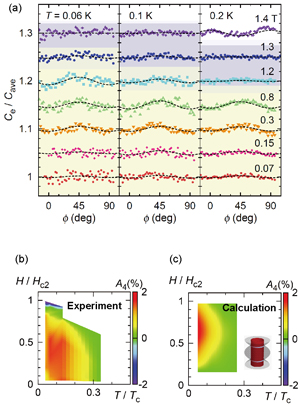Horizontal Lines of Nodes in the Superconducting Gap of Sr2RuO4: Evidence against the Anticipated Chiral p-wave Scenario
Sakakibara Group
The layered-perovskite superconductor Sr2RuO4 has been a leading candidate of a spin-triplet chiral p-wave superconductor; the spin-triplet pairing (chiral state) was suggested by the invariant spin susceptibility across Tc (time-reversal symmetry breaking in the superconducting state) [1]. However, the recently-discovered first-order superconducting transition, reminiscent of the Pauli-paramagnetic effect, under an in-plane magnetic field is likely to favor the spin-singlet scenario [2, 3]. Moreover, whereas symmetry-protected nodes are forbidden in the spin-triplet scenario, the presence of nodes has been suggested from various thermodynamic experiments. Thus, the order parameter of Sr2RuO4 has remained controversial.

Fig. 1. (a) Field-angle dependence of the specific heat under a rotating magnetic field within the ab plane of Sr2RuO4. (b) The H-T phase diagram of the normalized amplitude A4 of the fourfold specific-heat oscillation. (c) The calculated results of A4(T, H) obtained by assuming a horizontal line node gap (inset), anisotropic in-plane Fermi velocity, and the Pauli-paramagnetic effect.
Recently, we have developed field-angle-resolved measurements of the specific heat as a powerful technique to identify the superconducting gap structure [4]. Here, in order to provide hints for resolving the puzzling issues on Sr2RuO4, we have performed the field-angle-resolved measurements at low temperatures down to 0.06 K by using a high-quality single crystal (Tc = 1.505 K) [5]. By subtracting the Schottky-type anomaly originating from the addenda heat capacity very precisely, we have revealed that the low-field specific heat of our sample increases in proportion to H1/2 with no multigap structure at 0.06 K. This behavior is in sharp contrast to the previous reports [6], and suggests that multiple gaps on the three bands (α, β, and γ) equivalently survive up to high fields and possess nodes somewhere. In addition, the fourfold oscillation in the specific heat observed under an in-plane rotating field [6] does not change its sign even at a low temperature of 0.04Tc in the low-field region (Figs. 1(a) and 1(b)).
The absence of a sign change in the fourfold specific-heat oscillation is incompatible with vertical line node scenario, such as the dx2-y2- and dxy-wave type; the present results are clearly different from the cases of vertical line node superconductors such as CeCoIn5 [4]. Also, it is obvious that the present observations cannot be explained within the anticipated chiral-p-wave scenario. By contrast, the results favorably support the presence of horizontal line nodes; the specific-heat oscillation arises due to nodal quasiparticles that have anisotropic in-plane Fermi velocity of the cylindrical γ band. On the basis of microscopic theoretical calculations, the observed field and temperature variations of the specific-heat oscillation can be reproduced by assuming the presence of horizontal line nodes on cylindrical bands whose Fermi velocity is highly anisotropic within the plane (Fig. 1(c)). The agreement between the experimental and the calculated results becomes even better by taking into account the Pauli-paramagnetic effect. Our findings, in particular the presence of horizontal line nodes in the gap, challenge the historical view of Sr2RuO4 and call for reconsideration of its order parameter.
References
- [1] Y. Maeno, S. Kittaka, T. Nomura, S. Yonezawa, and K. Ishida, J. Phys. Soc. Jpn. 81, 011009 (2012).
- [2] S. Yonezawa, T. Kajikawa, and Y. Maeno, Phys. Rev. Lett. 110, 077003 (2013).
- [3] S. Kittaka et al., Phys. Rev. B 90, 220502(R) (2014).
- [4] T. Sakakibara, S. Kittaka, and K. Machida, Rep. Prog. Phys. 79, 094002 (2016).
- [5] S. Kittaka et al., J. Phys. Soc. Jpn. 87, 093703 (2018).
- [6] K. Deguchi et al., J. Phys. Rev. Lett. 92, 047002 (2004).
